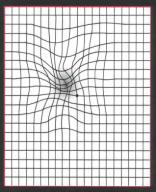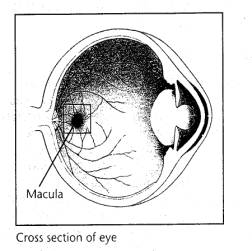Age-related macular degeneration (AMD) is an aging change in the area of the retina that provides central vision. AMD results from damage to the photoreceptors within the macula, a tiny area at the center of the retina in the back of the eye (see diagram). People with AMD may develop deterioration of their central vision but usually retain their peripheral sight. Its cause is not well understood and no treatment has been uniformly effective. It is the leading cause of severe visual loss in people over 65.
Macular degeneration may result in a decrease in central vision, such as difficulty identifying faces or reading road signs. Additionally there may be a distortion of images where straight lines appear bent:
 |
 |
| Normal | Distorted |
"Dry" and "Wet" Forms of Macular Degeneration
The "dry" type of AMD occurs when retinal aging limits visual performance. This type accounts for 90% of the disease and does not cause a total loss of central vision. The "wet" form, by contrast, involves abnormal blood vessel development that damages the macula. This type is often more visually threatening, and occurs in only 10% of AMD patients but causes 90% of the disease's severe visual loss.
Prevention of Dry and Wet Macular Degeneration
The biggest risk factor for development of this problem is simply getting older and your genetic make-up. It usually hits after age 50, and, by the time you're 75, about 15 percent of all people have it. but there are certain things that help to reduce the incidence:
Sunglasses: Protect the retina from potentially damaging ultraviolet light.
Smoking: A study published in the July 2007 issue of Archives of Ophthalmology found that current smokers are four times more likely to develop this eye problem than nonsmokers. This is yet another of many compelling reasons not to smoke. So if you do, PLEASE QUIT !!
Nutrition: The Age Related Eye Disease Study (AREDS) demonstrated that dietary supplementation of antioxidants and zinc reduces the progression from intermediate to advanced dry AMD by 25%, and the chance of further visual loss by 19%. A review of these results is available at https://www.nei.nih.gov/amd.
The specific total daily amounts of antioxidants and zinc are:
» 500 milligrams of vitamin C
» 400 International Units of vitamin E
» 15 milligrams of beta-carotene (equivalent to 25,000 International Units of vitamin A)
» 80 milligrams of zinc as zinc oxide
» 2 milligrams of copper (as cupric oxide)
Studies are underway to determine the role of lutein and zeaxanthin to protect against developing or worsening AMD. The following may be used as a guide to such potentially beneficial foods:
| Kale | 21,900 | |
| Collard Greens | 16,300 | |
| Spinach (cooked, drained) | 12,600 | |
| Spinach (raw) | 10,200 | |
| Parsley (not dried) | 10,200 | |
| Mustard Greens | 9,900 | |
| Dill (Not dried) | 6,700 | |
| Celery | 3,600 | |
| Scallions (raw) | 2,100 | |
| Leeks (raw) | 1,900 | |
| Broccoli (raw) | 1,900 | |
| Broccoli (cooked) | 1,800 | |
| Leaf lettuce | 1,800 | |
| Green peas | 1,700 | |
| Pumpkin | 1500 | |
| Brussels sprouts | 1,300 | |
| Summer squash | 1,200 | |
| Corn (yellow) | 790 | |
| Yellow pepper (raw) | 770 | |
| Green beans | 740 | |
| Green pepper | 700 | |
| Cucumber pickle | 510 | |
| Green olives | 510 |
Treatment for Dry Macular Degeneration
No specific treatment has been shown to reduce dry AMD, though sunglasses and dietary supplementation may delay its progression.
Research in Dry Macular Degeneration: Two large multicenter trials, the Complications of Macular Degeneration Prevention Trial (CAPT) and the Prophylactic Treatment of Macular Degeneration (PTAMD), are underway to determine if low-intensity laser treatment of retinal aging deposits (drusen) reduces the development or advancement of AMD. These trials are also evaluating whether visual function could be improved with such laser treatment.
Treatment for Wet Macular Degeneration
Therapeutic options for specific cases of wet AMD include antiangiogenic drugs and laser treatment.
Antiangiogenic drugs: Antiangiogenic drugs have recently been used in wet AMD to stop the formation of new blood vessels that can result in scarring and eventual loss of central vision. These medications block Vascular Endothelial Growth Factor (VEGF), a substance responsible for the growth of new blood vessels. In most cases these drugs are injected into or around the eye.
Lucentis was FDA-approved in June 2006, and is an antibody fragment to VEGF. 95% of patients maintained or improved vision (defined as a loss of less than 15 letters in visual acuity) at one year when treated with Lucentis injections, compared to approximately 62% of those treated in the control arm. Lucentis treatment often involves injection into the eye every month.
Avastin is an investigational antiangiogenic cancer medication that has been used off-label for wet AMD. Avastin is manufactured by the same company, Genentech, that produces Lucentis, and treatment involves injection into the eye.
Macugen was FDA-approved in December 2004. Studies have demonstrated that Macugen stabilized or improved vision in 33% of the patients in clinical trials, while the same results occurred in 23% of a control group not given Macugen. 71% of the patients given Macugen lost less than three lines of vision during the year, compared with 55% of the control group. Macugen treatment often involves injection into the eye every six weeks.
Steroid therapy, often involving injection into the eye, may be used by itself or in combination with other AMD treatments to reduce retinal inflammation involved in new blood vessel growth of wet AMD.
Conventional Laser Therapy for Wet AMD: Involves a strong beam of light directed to the areas of abnormal blood vessel growth. Since the laser energy damages the areas of treatment, only specific types of wet AMD are candidates, and visual function afterward does not improve.
New Laser Treatments for Wet AMD: The specific new blood vessels of wet AMD may be selectively targeted during laser treatment following intravenous injection (typically into the arm) of the dye Visudyne. Such laser treatment is termed Photodynamic Therapy, and typically involves many exams and treatment sessions. During each treatment, dye is injected and then the eye is exposed to red laser light which specifically treats the abnormal new blood vessels absorbing the dye. There is relatively little effect on the surrounding normal eye tissue. Visual improvement only occurs in about 15 to 20% of cases, but further visual loss is prevented in another 50 to 60%.
Transpupillary Thermal Therapy: Photodynamic therapy has not been shown to be effective when abnormal blood vessels grow in to the center of the eye in a diffuse pattern. Transpupillary Thermal Therapy may be useful for such patients. Instead of a hot laser, this technique uses a cooler laser to heat the abnormal blood vessels more gently. This type of treatment typically stabilizes wet AMD in 50 to 70% of patients.
Implantable telescope: In July 2010 the FDA approved a tiny implanted intraocular device that magnifies images onto the retina to improve central vision damaged by AMD or Stargardt's macular dystrophy. The Implantable Miniature Telescope (IMT) from VisionCare Ophthalmic Technologies Inc. (Saratoga, California) magnifies the overall image, while reducing the relative size of the central blind spot caused by central retinal degeneration. CentraSight is the patient care program managing the IMT. It includes not only the surgery to implant the telescope, but also an extensive training program to improve the chance of success. For more information see www.centrasight.com.
Research in Wet Macular Degeneration: Drugs, such as thalidomide, Retaane, and other anti-VEGF therapies, are being investigated in terms of their potential to inhibit new vessel growth of wet AMD. Additionally, new surgical strategies being evaluated include Macular Translocation Surgery, during which the retina is detached and the macula is relocated away from blood vessel growth, and Radiation Therapy, directly applied to the abnormal new blood vessels. These areas of AMD research are being watched with great interest so that patients can be offered the most effective proven strategy depending on their risk factors and stage of retinal health.

